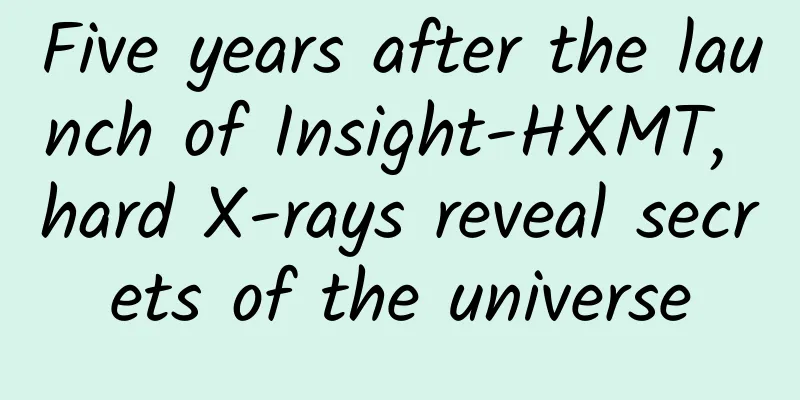Five years after the launch of Insight-HXMT, hard X-rays reveal secrets of the universe

|
In June this year, the Insight-HXMT satellite celebrated its fifth anniversary in orbit. According to the design, its life span is only four years. Since it is operating normally and its performance is still good, scientists held a meeting to extend the life of the satellite and decided to let it work for another two years. At present, the onboard fuel of the satellite platform can meet the needs of multiple orbital increases, and it is expected that the satellite can still operate stably for several years. The full name of the "Hard X-ray Modulation Telescope Satellite" is my country's first X-ray astronomical satellite. It operates in a 550-kilometer near-Earth circular orbit and is mainly used to observe and study black holes, neutron stars, gamma-ray bursts, etc. It is also a hard-won space telescope. From the proposal of the project in 1993 to the establishment of the satellite project and then to the launch of the satellite, it took 24 years, which embodies the wisdom and efforts of several generations of Chinese scientists. The Insight-HXMT satellite achieves its scientific goals mainly by observing X-rays emitted by celestial bodies in the universe. X-rays are essentially electromagnetic waves like visible light, but their wavelength is shorter. If an ordinary optical telescope is pointed at an X-ray celestial body source, it is impossible to obtain an X-ray image. In order to solve this problem, scientists have come up with many solutions, such as inventing a grazing mirror, but it is very difficult to make. Chinese scientists have taken a different approach to algorithms and proposed a direct demodulation imaging method. The hard X-ray modulation telescope came into being with the proposal of this method. In the early 1990s, Academician Li Tibei and Researcher Wu Mei from the Institute of High Energy Physics of the Chinese Academy of Sciences found a new algorithm through continuous exploration. Even if focusing cannot be achieved, the demodulated signal can still be effectively restored to an image. This method is called direct demodulation technology and has achieved satisfactory accuracy. Academician Li Tibei combined scanning detection technology with this image processing technology to propose the concept of a hard X-ray modulation telescope, hoping that this simple and mature method can make up for the shortcomings of domestic technology, conduct imaging observations of hard X-ray sources, and obtain a "sky map." The Hard X-ray Modulation Telescope has only retained its original name, but in fact it is no longer limited to the hard X-ray energy band. It includes high-energy X-ray telescopes, medium-energy X-ray telescopes and low-energy X-ray telescopes, and for the first time achieved coverage of the energy range of 1-250 kiloelectronvolts, which is conducive to observing and studying the radiation mechanism of X-ray celestial bodies from different energy bands. Zhang Shuangnan, the chief scientist of the satellite, creatively added the task of observing gamma-ray bursts, which expanded the satellite's energy coverage by 10 times on the original basis to 3 megaelectronvolts. The Insight-HXMT satellite has been in orbit for five years with its unique advantages, accumulating a wealth of scientific data and producing a series of major scientific achievements. For example, the Insight-HXMT satellite confirmed that fast radio bursts originated from magnetar bursts, solved the mystery of the origin of fast radio bursts, and directly and reliably measured the strongest magnetic field in the universe to date; the Insight-HXMT satellite discovered the relativistic jet closest to the black hole, discovered the plasma flow (corona) in a black hole binary that escapes the strong gravitational field of the black hole and moves outward at high speed, and observed the velocity evolution of the corona in a black hole binary for the first time. The Insight-HXMT satellite carried out X-ray pulsar navigation experiments, monitored the world's first gravitational wave event caused by the merger of two neutron stars, completely detected the high-energy radiation process of the largest flare in the 24th solar activity cycle, and clearly observed for the first time a panoramic view of the explosion process of a black hole binary. It has made important contributions in the fields of gravitational waves, gamma-ray bursts, fast radio bursts, black holes and neutron stars. |
>>: The "smallest sun of the year" appeared in the sky today, at 15:11!
Recommend
After "Yang Kang", please pay attention! Don't rush some things——
Source: CCTV News Client...
Zero-starting teaching: APP first release skills + omni-channel
It is not easy to make a good product APP, but it...
Tesla's batteries depend on its Gigafactory's history
Tesla has just released its second quarter 2016 f...
The new energy vehicle industry has entered the most stringent regulatory period, and there is zero tolerance for fraudulent subsidies
In early 2016, the General Offices of the Ministr...
14 amazing skills, information flow conversion increased by 100%!
This article is a summary of the book "The B...
How to effectively deliver short video information flow? Analysis of Tik Tok gameplay
This article mainly introduces the preparations b...
A new satellite has been added to Jupiter: How was it discovered? By whom?
Astronomy enthusiasts discover a new small satell...
37.2 trillion, what does that mean? He explores the mysteries of life from massive cell research
37.2 trillion, what does that mean? Every human b...
How much more is Huang Zheng’s wealth than Jack Ma? How much is Huang Zheng worth?
Huang Zheng's net worth exceeds Jack Ma Pindu...
How to manage mobile APPs that exceed their authority? Security awareness, technology, and regulations are indispensable
It is no longer surprising that mobile APPs obtai...
The history of technology and business behind the modern social order
Introduction to the science and technology busine...
Why does Microsoft prefer mobile keyboard apps recently?
[[163288]] Recently, Microsoft quietly launched a...
How to identify Baidu spider? How to attract Baidu spider?
When many SEO practitioners first come into conta...
Taizhou Mini Program Customization Company, how much does it cost to customize an e-book mini program?
There are two types of customization of Taizhou e...









